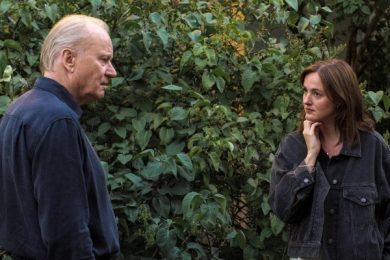The tales within The Ballad of Buster Scruggs are collectively somber, though some certainly more than others. That the film comes from the Coen Brothers will always, on its own, make it more interesting, but to see them experiment here, not only by making a film with Netflix, but also by filling an entire film with shorter films – connected only by mood, technique, and the vast expanses of the Old American West – perhaps shows the unique turns that these filmmaking brothers are willing to make well into the fourth decade of their careers. There are six stories, all framed by a close-up of a worn hardcover book whose pages we flip through at the beginning and end of each section. The Coens fill Buster Scruggs with literary aspiration and like most story collections, some of the tales are succinct and deliberate, while some are grander and filled with more meaning.
The film’s first two parts, “The Ballad of Buster Scruggs” and “Near Algodones”, are concluded within the film’s first forty minutes. One involves the nominal outlaw, Buster Scruggs (Tim Blake Nelson), who presents himself as a self-narrating showman dressed in angelic white and a song voice always at the ready. The other watches a mediocre bank robber (James Franco), whose talents for escaping death surpasses his ability to steal money. In both stories, we’re privy to men who are aided by skill and luck – until they aren’t. In “Meal Ticket”, Liam Neeson is an aging impresario who travels the American West with an orator with no arms and legs (Harry Melling). This first half is grim, at times shockingly violent, and only occasionally softened by the Coens’ trademarked dark humor.
I must admit to feeling dread after the first three segments, fearing that the Coens had finally, fully embraced the nihilism their films have only circled in the past. Scruggs mixes the mythology of “the West” with its stark realities. There’s brutal violence, augmented moralities, and a lawlessness that feels like a stand-in for soullessness. This is pushed further by the performances, particularly from Nelson and Neeson, which project glee and indifference, respectively, in the face of the setting’s bleak horror. That changes drastically with “All Gold Canyon”, about a prospector (Tom Waits) in the Colorado mountains who searches for gold less as a search for personal wealth, but as a search for spiritual and emotional fulfillment. Depending on how you look at it, “Canyon” might be the only portion that doesn’t end in total tragedy.
After that, we have “The Gal Who Got Rattled” and “The Mortal Remains”. The first is Scruggs’ longest, most developed story about a woman (Zoe Kazan) who ends up alone on the Oregon Trail after the death of her brother. She ends up sparking a friendship with one of the trail heads (Bill Heck), and romance blooms – though not for long. The final story is the film’s most loquacious, essentially a chamber drama aboard a stagecoach where differing personalities butt heads on their way to Fort Morgan, Colorado. Tyne Daly, Saul Rubinek, Chelcie Ross and Brendan Gleeson are among the patrons, but they all take a backseat to Jonjo O’Neill, who plays a bounty hunter who works along with Gleeson’s Irishman. By the time “Mortal Remains” concludes, as does the film itself, we may realize how once again the Coens have played a devilish trick on us.
Buster Scruggs is still very much about the themes of its first three, more diabolical stories, but it’s the film’s concluding segments that bring the entire experience into shape. Originally planned as a Netflix mini-series, it instead became a feature film, and I think that’s appropriate. If anything, Buster Scruggs proves how difficult it can be for the Coens to shoehorn the entirety of their imagination into a shorter model of storytelling. Like the spell-binding landscapes they shoot throughout the film, they prefer vast canvases. With the usual crew, including costumer Mary Zophres, composer Carter Burwell, production designer Jess Gonchor, and substituting Bruno Delbonnel for their usual cinematographer Roger Deakins, Buster Scruggs is an expertly crafted piece of cinema, a beautiful marvel of Americana.
Their script (scripts?) covers familiar ground of morality and mortality, the meaning of life versus the meaninglessness of life, the various ways in which man is outmatched against nature. The Coens are simply presenting it in a different way. Like something from Jarmusch or Linklater, the writer-directors are eschewing the more traditional functions that they had become comfortable within. Piece by piece, Buster Scruggs is a mixed bag. It’s first portion in particular – the one in which the film gains its name – feels callous and empty, too vicious and cloying, like it’s begging to be disliked. But it’s only a minor detraction from a film that is unique both in a way we’d expect from the Coens, and also in some ways we wouldn’t expect.
Written, Produced and Directed by Joel Coen and Ethan Coen










